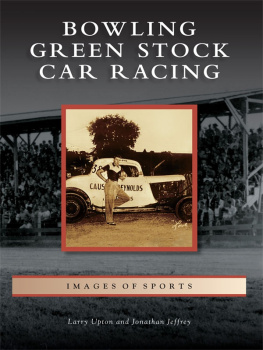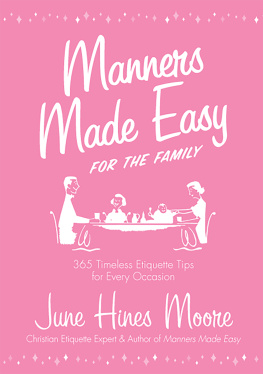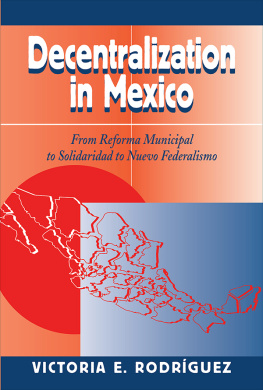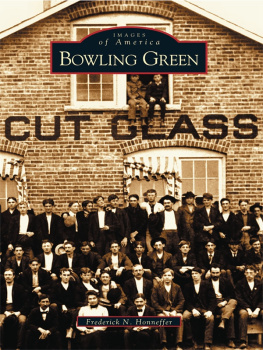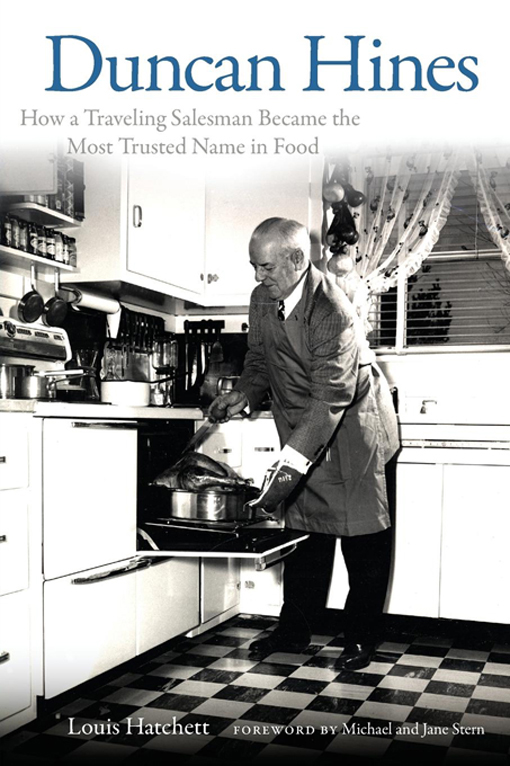D UNCAN H INES
Duncan Hines, standing before his huge collection of cookbooks, Bowling Green, Kentucky, Fall 1953.
Duncan Hines
How a Traveling Salesman
Became the Most Trusted
Name in Food
Louis Hatchett
Foreword by Michael and Jane Stern
Copyright 2014 by Louis Hatchett
The University Press of Kentucky
Scholarly publisher for the Commonwealth,
serving Bellarmine University, Berea College, Centre
College of Kentucky, Eastern Kentucky University,
The Filson Historical Society, Georgetown College,
Kentucky Historical Society, Kentucky State University,
Morehead State University, Murray State University,
Northern Kentucky University, Transylvania University,
University of Kentucky, University of Louisville,
and Western Kentucky University.
All rights reserved.
Editorial and Sales Offices: The University Press of Kentucky
663 South Limestone Street, Lexington, Kentucky 40508-4008
www.kentuckypress.com
Previously published in 2001 by Mercer University Press
The Library of Congress has cataloged the 2001 edition of this book as follows:
Hatchett, Louis.
Duncan Hines: the man behind the cake mix/Louis Hatchett.1st ed.
p. cm.
Includes bibliographical references and index.
ISBN 0-86554-773-4 (hardcover: alk. paper)
1. Hines, Duncan, 1880-1959. 2. BusinessmanUnited StatesBiography. 3. Food
industry and tradeUnited StatesBiography. 4. Hospitality industryUnited States
Biography.
I. Title.
HC102.5.H56 H38 2001
338.76640092dc21
2001004756
ISBN 978-0-8131-4459-7 (pbk.: alk. paper)
ISBN 978-0-8131-4484-9 (pdf)
ISBN 978-0-8131-4483-2 (epub)
This book is printed on acid-free paper meeting the requirements of the American National Standard for Permanence in Paper for Printed Library Materials.
Manufactured in the United States of America.

| Member of the Association of
American University Presses |
For my Mother and Father
Contents
by Michael and Jane Stern
P REFACE
No one had ever written a biography of Duncan Hines before, so I needed a lot of help. Fortunately, a number of people rallied to my cause; I apologize to anyone whom I have omitted in the following list. The most important person to this project was Duncan Hiness great niece, Cora Jane Spiller, who not only gave me her valuable time but who enthusiastically ran down leads for me when all other avenues to my investigation were blocked. Her enthusiasm for the book was infectious and encouraging from start to finish. Every biographer should have someone like her to work with. She has been with me through thick and thin from beginning and end; without her support, I would have abandoned this biography long ago.
This book originally took shape as a thesis for a Masters degree in History at Western Kentucky University in Bowling Green, Kentucky, the birthplace and home of Duncan Hines for his first 18 and last his 20 years. I wrote the book first and then scaled it down to 120 pages for the thesis. The first draft of the book was 840 manuscript pages, which I subsequently trimmed to 740 pages.
My main thesis adviser, Dr. Carol Crowe-Carraco, was the one who provided me with the day-to-day thread that helped bring the work to completion. But perhaps my greatest contacts, particularly on arcane questions of style and format, came from Nancy Baird, Connie Mills, and Sandy Staebel, all long-time employees of the Kentucky Library and Museum, which sits on the Western Kentucky University campus. When Dr. Crowe-Carraco was not available, all three answered my innumerable questions. As I worked on this manuscript 100 miles away from their offices, I must have called them 300 times in the course of a thousand days. They always helped when I asked, and I record my deepest appreciation here.
While writing this book, perhaps the biggest treasure trove of Hinesiana came when I went to the Procter and Gamble headquarters in Cincinnati, Ohio, then the manufacturers of the Duncan Hines cake mixes, and asked to see their Duncan Hines collection. I spoke with Ed Rider, head archivist at P&G, and after a couple of minutes, his staff brought out several large files of Duncan Hines material. After going over these files for an hour, I asked the P&G staff to xerox everything and send it to me. They complied, and about ten days later I received a forty-pound box that nearly mirrored their entire Duncan Hines collection. It took almost a year to fully digest and make use of everything they sent. I offer my sincerest thanks to Ed Rider and his staff for providing me with this material. This would have been a much shorter book without their cooperation.
During my two-year effort composing this book, a number of other people also helped me along the way. I want to thank Jane Jeffries for the critique of the first 300 pages of this book. I also want to thank her for asking me to discard the first 100 pages or so, which pertained not to Duncan Hines but the history of his family. Sometimes a writer can get carried away with the research, and I was including everything I found; I finally realized that not many people would be interested in the fact that Duncan Hiness brother, Porter, put in the first sewer system in Calhoun, Kentucky in 1899.
When Jane left the project, Wendy Yates took her place in critiquing the final product. When the manuscript had been completed, she read it and thought it to be boring, and after I reread it again, I had to agree. So I took a full year to rewrite the entire thing from top to bottomtwice. To Wendy I owe profuse gratitude.
There were a number of people that I interviewed that I would like to thank. Duncan Hiness brother-in-law, Robert Wright, provided me with some valuable personal insights on Hiness character; Thomas C. Dedman, of the Beaumont Inn in Harrodsburg, Kentucky, gave me plenty of corroborative insight into Hiness influence on the lodging industry; Paul Ford Davis supplied me with a wealth of information about his former employer; Sara Jane Meeks, Mary Herndon Cohron and Wanda Richey Eaton, three of Duncan Hiness secretaries in the 1950s, furnished me with a plethora of information concerning the working conditions while employed by Hines; Elizabeth Duncan Hines, the wife of his nephew, yielded some useful information; Edward and Robert Beebe, nephews of Duncan Hiness second wife, provided me with some information about their aunt that was unknown to the Hines family; Caroline Tyson Hines, offered me additional and corroborative insights into the personality of Duncan Hines; Maj. Gen. Richard Groves, a nephew of Duncan Hines and son of General Leslie Groves (Father of the Atomic Bomb), gave me some critical insights into the early years of Duncan Hiness life which opened up a whole vista of understanding; much help came from Paul Moore, who prepared most of the Duncan Hines guidebooks in the late 1940s and early 1950s; Top Orendorf, who was Duncan Hiness lawyer, also had some useful insights. Duncan Welch, who was Hiness great nephew, gave me all sorts of information as well as provided me with some hilarious stories. Larry Williams, of the Williams Printing Firm was a big help in providing me the history of his business and Hiness relation to it. Finally, I want to thank William Jenkins, a former professor of Government at Western Kentucky University, for providing me with a key clue in unraveling Duncan Hiness past.


